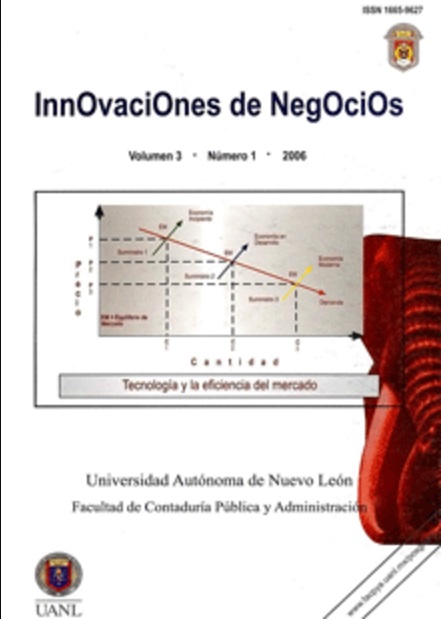Customer’s preferred service behaviors in two industries: the case of the mexican consumers
DOI:
https://doi.org/10.29105/rinn3.5-6Abstract
The interaction that occurs between a service provider and a customer has received a significant amount of attention in the services research stream. However, there is still little knowledge with regards to how consumers assess service encounters, and even less about what is important to consumers in different countries other than the U.S. Using Mexican consumers, a
group of behaviors (caring, courtesy, friendliness, and promptness) was investigated to determine their relative importance in interactions with medical and restaurant service encounters and their impact on satisfaction with those providers. Promptness was the only behavior that did not have an effect on satisfaction reflecting a society with a higher orientation for people-oriented behaviors.
Downloads
References
Alden, D., W. Hoyer, and C. Lee. 1993. Identifying Global and Culture-Specific Dimensions of Humor in Advertising: A Multinational Analysis. Journal of Marketing, 57(April): 64-75.
Anderson, E., C. Fornell, and D. Lehmann. 1994. Customer Satisfaction, Market Share, and Profitability: Findings From Sweden. Journal of Marketing, 58(July): 53-66.
Bateson, J. E. G. and E. Langeard. 1982. Consumer Uses of Common Dimensions in the Appraisal of Services. Advances in Consumer Research, 9(1): 173-176.
Bentler, P. M. and D. G Bonnet. 1980. Significance Tests and Goodness-of- fit in the Analysis o covariance structure. Psychological Bulletin, 88(3): 588-606.
Bitner, M. J. 1992. Evaluating Service Encounters: The Effects of Physical Surroundings and Employee Responses. Journal of Marketing, 54(April): 69-82.
Bitner, M. J., B. H. Booms, and M. S. Tetreault. 1990. The Service Encounter: Diagnosing Favorable and Unfavorable Incidents. Journal of Marketing, 54(January): 71-84.
Blodgett, J., K. Wakefield, and J. Barnes. 1995. The Effects of Customer Service on Consumer Complaining Behavior. Journal of Services Marketing, 9(4): 31-42.
Bowen, D. E., G. W. Stephen, and R. Folger. 1999. HRM and Service Fairness: How Being Fair with Employees Spills Over to Customers. Organizational Dynamics, 27(Winter): 7-23.
Bowers, M. R. and J. E. Swan. 1994. What Attributes Determine Quality and Satisfaction With Health Care Delivery? Health Care Management Review, 19(Fall): 2-15.
Brown, S. W., and T. A. Swartz. 1989. A Gap Analysis of Professional Service Quality. Journal of Marketing, 53 (April): 92-98.
Chandon, J. L., P. I. Leo, and J. Philippe. 1997. Service Encounter Dimensions – A Dyadic Perspective. International Journal of Service Industry Management, 8(1): 65-86.
Czepiel, J. A. 1990. Service Encounters and Service Relationships: Implications for Research. Journal of Business Research, 20: 13-21.
Fornell, C. 1992. A National Customer Satisfaction Barometer: The Swedish Experience. Journal of Marketing, 55(January): 1-21.
Goodwin, C. and C. D. Frame. 1989. Social Distance Within the Service Encounter: Does the Consumer Want to be your Friend? Advances in Consumer Research, 16: 64-71.
Goodwin, C., and K. L. Smith. 1990. Courtesy and Friendliness: Conflicting Goals for the Service Provider? Journal of Services Marketing, 4(Winter): 5-20.
Gotlieb, J., M. Levy, D. Grewal, and J. Lindsey -Mullikin. 2004. An Examination of Moderators of the Effects of Customers' Evaluation of Employee Courtesy on Attitude Toward the Service Firm. Journal of Applied Social Psychology, 34(April): 825-847.
INEGI. 1999. Censos Economicos en Mexico. (Economic Census in Mexico), http://www.inegi.gob.mx/est/contenidos/espanol/rutinas/ept.asp?t=econ04&c=1808.
Lovelock, C. H. 1983 Classifying Services to Gain Strategic Marketing Insights. Journal of Marketing, 47(Summer): 9-20.
McColl-Kennedy, J. R., and B. A. Sparks. 2003. Application of Fairness Theory to Service Failures and Service Recovery. Journal of Service Research, 5(February): 251-266.
Mattila, A. S. 1999. The Role of Culture and Purchase Motivation in Service Encounter Evaluations. Journal of Services Marketing, 13(4/5): 376-389.
Nunnally, J. C., and I. H. Bernstein. 1994. Psychometric Theory, McGraw Hill. N. Y.
O’Connor, S. J., R. M. Shewchuk, and M. R. Bowers. 1992. A Model of Service Quality Perceptions and Health Care Consumer Behavior. Journal of Hospital Marketing, 6(1):69-92.
Oliver, R. L. 1980. A Cognitive Model of the Antecedents and Consequences of Satisfaction Decisions. Journal of Marketing Research, 17(November): 460-469.
Oliver, R. L. 1999. Whence Consumer Loyalty? Journal of Marketing, 63(October): 33-44.
O’Malley, J. 2004. The Total Service Experience. Marketing Health Services, 24(Fall): 12-13.
Parasuraman, A., L. L. Berry, and V. A. Zeithaml. 1991. Understanding Customers Expectations of Service. Sloan Management Review, 32(Spring): 39-48.
Parasuraman, A., V., A. Zeithaml, and L. L. Berry. 1985. A Conceptual Model of Service Quality and Its Implications for Future Research. Journal of Marketing, 49(Fall): 41-50.
Parasuraman, A., V. A. Zeithaml, and L. L. Berry. 1988. SERVQUAL: A Multiple Item Scale For Measuring Customer Perceptions of Service Quality. Journal of Retailing, 64(Spring): 12-40.
Price, L. L. and E. J. Arnould. 1999. Commercial Friendships: Service Provider-Client Relationships in Context. Journal of Marketing, 63(October): 38-56.
Price, L. L., E. J. Arnould, and P. Tierney. 1995. Going to Extremes: Managing Service Encounters and Assessing Provider Performance. Journal of Marketing, 59(April): 83-97.
Rigdon, E. E. 1995. A Necessary and Sufficient Identification Rule for Structural Models Estimated in Practice. Multivariate Behavioral Research, 30(3): 359-383.
Rust, R. T., A. J. Zahorik, and T. L. Keiningham. 1996. Service Marketing, New York: HarperCollins.
Schneider, B. J. 1980. “Service Organization: Climate is Crucial. Organizational Dynamics,9(Autumn): 52-65.
Scott, G. 2001. Accountability for Service Excellence. Journal of Healthcare Management, 46(May/Jun): 152-155.
Solomon, M. R., C. F. Surprenant, J. A. Czepiel, and E. G. Gutman. 1985. A Role Theory Perspective on Dyadic Interactions: The Service Encounter. Journal of Marketing, 49(Winter): 99-11.
Strasser, S., and S. Schweikhart. 1995. Satisfaction with Medical Care. Journal of Health Care Marketing, 15(Fall): 34-43.
Sundaram, D. S., and C. Webster. 2001. The Role of Nonverbal Communication in Service Encounters. Journal of Personal Selling and Sales Management, 21(Winter): 73.
Surprenant, C. F., and S. M. R. 1987. Predictability and Personalization in the Service Encounter. Journal of Marketing, 51(April): 86-96.
Taylor, S. 1994. Waiting for Service: The Relationship Between Delays and Evaluation of Service. Journal of Marketing, 58(April): 56-69.
Tsai, W. C. 2001. Determinants and Consequences of employee Displayed Positive Emotions. Journal of Management, 27(4): 497-512.
Verma, H. V. 2003. Customer Outrage and Delight. Journal of Services Research, 3(Apr-Sep):119-133.
Winsted, K. F. 1997. The Service Experience In Two Cultures: A Behavioral Perspective. Journal of Retailing, 73(Fall): 337-360.
Winsted, K. F. 1999. Evaluating Service Encounters: A Cross-Cultural and Cross-Industry Exploration. Journal of Marketing Theory and Practice, 7(Spring): 106-122.
Winsted, K. F. 2000. Service Behaviors That Lead to Satisfied Customers. European Journal of Marketing, 34(3/4): 399-417.
Zeithaml, V. A. 1981. How Consumer Evaluation Processes Differ Between Goods and Services In: K. F. Winsted (ed.), Evaluating Service Encounters: A Cross-Cultural and Cross-Industry Exploration. Journal of Marketing Theory and Practice, 7(Spring): 106-122.
Downloads
Published
How to Cite
Issue
Section
License
Copyright (c) 2017 Innovaciones de Negocios

This work is licensed under a Creative Commons Attribution-NonCommercial-ShareAlike 4.0 International License.
The InnOvaciOnes de NegOciOs magazine is a free and open access electronic magazine of a scientific-academic nature and is a publication of the Autonomous University of Nuevo León, in which the authors retain their copyright and grant the magazine the exclusive right to first publication of the work. Third parties are allowed to use the published content, as long as the authorship of the work is acknowledged and the first publication in this journal is cited.
For more information, please contact the Research Secretary (FACPyA) of the Autonomous University of Nuevo León. Telephone: (81) 1340-4430. Email: revinnova@uanl.mx










